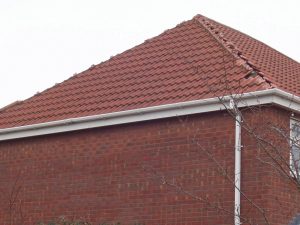Understanding wind loadings is crucial for a successful roof, as the structural design can prevent damage to a roof.
Wind load is the load in pounds per square foot placed on the exterior of the roof by wind, this is impacted by the angle that the wind strikes the roof, as well as the shape of it. Preventing wind damage involves strengthening areas where the roof could come apart. For example, roof overhangs tend to trap air beneath them, resulting in high uplifting forces, making it susceptible to damage.
Wind speeds and loading vary all over the UK and there are several factors you need to bear in mind when designing a roof and deciding how to fix it in place.
LOCATION. LOCATION. LOCATION.
The main factor to consider is location and topography; where the building is and what surrounds it. For instance, is the building next to open terrain, such as the sea or a plain? Wind speed over flat surfaces is a lot faster than when it’s been disrupted by hills.
Similarly, wind gains speed as it moves uphill: the steeper the slope, the greater the wind uplift. This means buildings at the crest of a hill need different fixings to those at the bottom. As a rule of thumb, we add hills into our calculations when a slope is more than 10% and when the building is more than halfway up.
The basic rule is that mono pitch roofs have the strongest wind uplift, whatever their pitch but, generally, the lower the roof pitch, the more wind uplift there is acting on it. Steeper roof pitches give some shelter to their leeside (negative) while lower pitches give less protection to their leeside, as well as exposing their leading edge. Chimneys and dormers can also cause turbulence at the perimeters.
UNDERLAYS
Some of the most important parts of the roof are those you can’t see. Fixings and underlay play a huge role in the integrity of a building’s roof but are as invisible as its foundations.

Research shows that roofs without underlay are five times more likely to sustain damage than those with underlay. This is because the underlay keeps the internal and external pressures separate. Internally, uplift forces act on the roof underlay whenever air can move within the building to the underside of the roof covering. Instead of this uplift load affecting the underside of the roof, its full impact is taken by the underlay.
FIXINGS
Every tile or fitting must be fixed using either a nail, a screw or a specially designed clip. Research shows that the most secure fixing is a combination of both nail and clip, giving a resistance of more than 200 Newtons/m2 – that’s more than seven times as secure as a single nail or twice as strong as a fully clipped.
Most tile failures on a pitched roof occur because there has not been any fixing specification. BS 5534:2014, the latest Standard, requires a calculated fixing specification for your roof. It’s important you get one for each job and each tile type because the specification can vary between manufacturers and needs to be tailored to each site and location.
Understanding the different factors that affect how wind influences a building is an essential part of creating a successful roof. The location, topography, underlay and fixings each need to be considered. Put them all together and your roof should stand the test of time.


